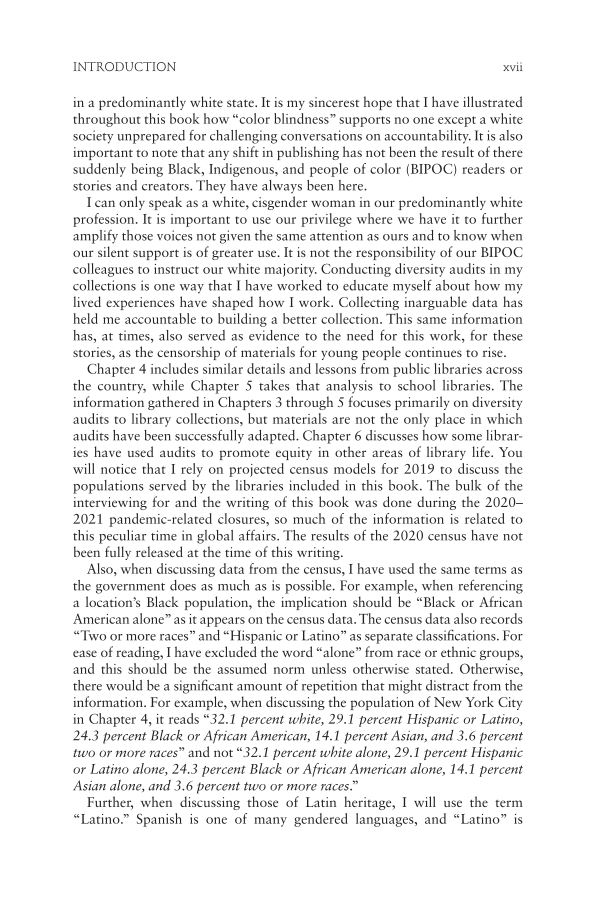Introduction xvii in a predominantly white state. It is my sincerest hope that I have illustrated throughout this book how “color blindness” supports no one except a white society unprepared for challenging conversations on accountability. It is also important to note that any shift in publishing has not been the result of there suddenly being Black, Indigenous, and people of color (BIPOC) readers or stories and creators. They have always been here. I can only speak as a white, cisgender woman in our predominantly white profession. It is important to use our privilege where we have it to further amplify those voices not given the same attention as ours and to know when our silent support is of greater use. It is not the responsibility of our BIPOC colleagues to instruct our white majority. Conducting diversity audits in my collections is one way that I have worked to educate myself about how my lived experiences have shaped how I work. Collecting inarguable data has held me accountable to building a better collection. This same information has, at times, also served as evidence to the need for this work, for these stories, as the censorship of materials for young people continues to rise. Chapter 4 includes similar details and lessons from public libraries across the country, while Chapter 5 takes that analysis to school libraries. The information gathered in Chapters 3 through 5 focuses primarily on diversity audits to library collections, but materials are not the only place in which audits have been successfully adapted. Chapter 6 discusses how some librar- ies have used audits to promote equity in other areas of library life. You will notice that I rely on projected census models for 2019 to discuss the populations served by the libraries included in this book. The bulk of the interviewing for and the writing of this book was done during the 2020– 2021 pandemic-related closures, so much of the information is related to this peculiar time in global affairs. The results of the 2020 census have not been fully released at the time of this writing. Also, when discussing data from the census, I have used the same terms as the government does as much as is possible. For example, when referencing a location’s Black population, the implication should be “Black or African American alone” as it appears on the census data. The census data also records “Two or more races” and “Hispanic or Latino” as separate classifications. For ease of reading, I have excluded the word “alone” from race or ethnic groups, and this should be the assumed norm unless otherwise stated. Otherwise, there would be a significant amount of repetition that might distract from the information. For example, when discussing the population of New York City in Chapter 4, it reads “32.1 percent white, 29.1 percent Hispanic or Latino, 24.3 percent Black or African American, 14.1 percent Asian, and 3.6 percent two or more races” and not “32.1 percent white alone, 29.1 percent Hispanic or Latino alone, 24.3 percent Black or African American alone, 14.1 percent Asian alone, and 3.6 percent two or more races.” Further, when discussing those of Latin heritage, I will use the term “Latino.” Spanish is one of many gendered languages, and “Latino” is
Document Details My Account Print multiple pages
Print
You have printed 0 times in the last 24 hours.
Your print count will reset on at .
You may print 0 more time(s) before then.
You may print a maximum of 0 pages at a time.

































































































































































